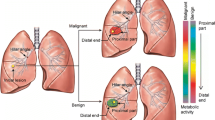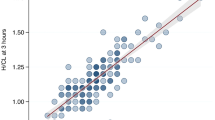Abstract
A single photon emission computed tomography (SPECT) with201Tl chloride (Tl-201) was carried out prospectively in 50 patients with pulmonary nodules and its diagnostic value was compared with those of67Ga citrate (Ga-67) and99mTc-labeled hexamethyl-propyleneamineoxime (Tc-99m-HMPAO). Tl-201 SPECT provided 88% (early)–91% (delayed) sensitivity, 85% (early and delayed) specificity and 87% (early)–89% (delayed) accuracy. The sensitivity of the Tl-201 planar image was 56 (early)–62% (delayed), which was significantly lower than that of SPECT. Delayed SPECT images at 2 hour postinjection were more preferable to disclose the malignant pulmonary nodule than early SPECT images at 15 minutes postinjection. The application of SPECT with Ga-67 failed to improve the sensitivity of planar imaging for malignant pulmonary nodules. Tc-99m-HMPAO was concentrated in 62% of 13 patients with malignant pulmonary nodules, which was slightly higher than Ga-67 in 54% of 28 patients. In an analysis of the histologic types of lung cancer, the sensitivity of Tl-201 was not significantly different in all types. On the other hand, Ga-67 was positive only in 25% of 12 patients with adenocarcinoma.
A combination of SPECT and Tl-201 is the best choice among routine scintigraphic techniques for depicting malignant pulmonary nodules. The Tl-201 SPECT image may play a complementary role in the characterization of pulmonary nodules which are revealed on a plain radiograph and computed tomography.
Similar content being viewed by others
References
Wagner HN, Conti PS: Advances in medical imaging for cancer diagnosis and treatment.Cancer 67 (suppl. 15): 1121–1128, 1991
Bekerman C, Hoffer PB, Bitran JD: The role of gallium-67 in the clinical evaluation of cancer.Semin Nucl Med 14: 296–323, 1984
Bekerman C, Caride VJ, Hoffer PG, et al: Noninvasive staging of lung cancer. Indications and limitations of gallium-67 citrate imaging.Radiol Clin North Am 28: 497–510, 1990
Klech H, Kohn H, Happmann, et al: Thoracic imaging with67gallium.Eur J Nucl Med 13: S24-S36, 1987
Itoh K: Tumor scintigraphy in lung and mediastinum. In: Hisada K, Furudate M, Sasaki Y eds:A new textbook of clinical nuclear medicine (1st ed.). Tokyo, kanehara Shuppan, pp 241–242, 1986 (in Japanese)
Coleman RE: Single photon emission computed tomography and positron emission tomography in cancer imaging.Cancer 67 (suppl. 15): 1261–1270, 1991.
Tonami N, Shuke N, Yokoyama K, et al: Thallium-201 single photon emission computed tomography in the evaluation of suspected lung cancer.J Nucl Med 30: 997–1004, 1989
Tonami N, Hisada K, Watanabe Y, et al:201Tl single photon emission computed tomography in the diagnosis of lung cancer.Rinshyo Hoshyasen 35: 825–832, 1990 (in Japanese)
Sessler MJ, Geek P, Maul FD, et al: New aspects of cellular thallium uptake: Tl, Na, Cl co transport is the central mechanism of ion uptake.Nuklearmedizin 25: 24–27, 1986
Tonami N, Hisada K: Clinical experience of tumor imaging with Tl-201-chloride.Clin Nucl Med 2: 75–81, 1977
Itoh K: Study on localization of hyperfunctioning parathyroid glands by99Tl-99mTc subtraction scintigraphy.Hokkaido Igakuzashi 59: 701–720, 1984 (in Japanese)
Winzelberg GG, Hyvovitz JD: Radionuclide imaging of parathyroid tumors: historical perspectives and newer techniques.Semin Nucl Med 15: 161–169 1985
Kaplan WD, Takvorian T, Morris JH, et al: Thallium-201 brain imaging: a comparative study with pathologic correlation.J Nucl Med 28:47–52, 1987
Neirinckx RD, Canning LR, Piper IM, et al: Technetium-99m d,l-HM-PAO: a new radiopharmaceutical for SPECT imaging of regional cerebral blood perfusion.J Nucl Med 28: 191–202, 1987
Irvine AT, Flower MA, Ott RJ, et al: An evaluation of99mTc-HMPAO uptake in cerebral gliomas—a comparison with X-ray CT.Eur J Nucl Med 16: 293–298, 1990
Oshima M, Itoh K, Okae S, et al: Evaluation of primary lung carcinoma using technetium 99m-hexamethylpropylene amine oxime: preliminary clinical experience.Eur J Nucl Med 16: 859–864, 1990
Lebowitz E, Greene MW, Fairchild R, et al: Thallium-201 for medical use. I.J Nucl Med 16: 151–155, 1975
Bradley-Moore PR, Lebowitz E, Greene MW, et al: Thallium-201 for medical use. II: biologic behavior.J Nucl Med 16: 156–160, 1975
Ando A, Ando I, Katayama M, et al: Biodistributions of Tl-201 in tumor bearing animals and inflammatory lesions induced in animals.Eur J Nucl Med 12: 567–572, 1987
Shin W-J, Magoun S, Stopp V, et al: Thallium-201-chloride lung imaging for bronchogenic carcinoma.J Nucl Med Tech 2: 83–86, 1991
Littleton JT, Durizch ML, Moeller G, et al: Pulmonary masses: contrast enhancement.Radiology 177: 861–871, 1990
Mountz JM, Raymond PA, McKeever PE, et al: Specific localization of thallium in human high-grade astrocytoma by microautoradiography.Cancer Res 49: 4053–4056, 1989
Ando A, Ando I, Katayama M, et al: Biodistribution of radioactive alkaline metals in tumor bearing animals: comparison with201Tl.Eur J Nucl Med 14: 352–357, 1988
Pohost GM, Alpert NM, Ingwall JS, et al: Thallium redistribution: mechanism and clinical utility.Semin Nucl Med 10: 70–93, 1980
Togawa T, Suzuki A, Higuchi Y, et al:201T1 to67Ga crude uptake ratio in primary lung cancer with reference to histological type.Haigan 25: 187–194, 1985 (in Japanese)
Larson SM, Rasey JS, Allen DR, et al: Common pathway for tumor cell uptake of gallium-67 and iron-59 via a transferrin receptor.J Natl Cancer Inst 64: 41–53, 1980
Chitambar CR, Zivkovic-Gilgenbach Z: Role of acidic receptosome in the uptake and retention of67Ga by human leukemic HL60 cells.Cancer Res 50: 1484–1487, 1990
Author information
Authors and Affiliations
Rights and permissions
About this article
Cite this article
Itoh, K., Takekawa, H., Tsukamoto, E. et al. Single photon emission computed tomography using201Tl chloride in pulmonary nodules: Comparison with67Ga citrate and99mTc-labeled hexamethyl-propyleneamine-oxime. Ann Nucl Med 6, 253–260 (1992). https://doi.org/10.1007/BF03164663
Received:
Accepted:
Issue Date:
DOI: https://doi.org/10.1007/BF03164663




